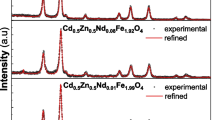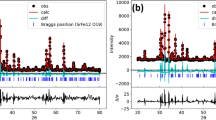Abstract
The crystal chemistry of a ferroaxinite from Colebrook Hill, Rosebery district, Tasmania, Australia, was investigated by electron microprobe analysis in wavelength-dispersive mode, inductively coupled plasma–atomic emission spectroscopy (ICP–AES), 57Fe Mössbauer spectroscopy and single-crystal neutron diffraction at 293 K. The chemical formula obtained on the basis of the ICP–AES data is the following: \( ^{X1,X2} {\text{Ca}}_{4.03} \,^{Y} \left( {{\text{Mn}}_{0.42} {\text{Mg}}_{0.23} {\text{Fe}}^{2 + }_{1.39} } \right)_{\varSigma 2.04} \,^{Z1,Z2} \left( {{\text{Fe}}^{3 + }_{0.15} {\text{Al}}_{3.55} {\text{Ti}}_{0.12} } \right)_{\varSigma 3.82} \,^{T1,T2,T3,T4} \left( {{\text{Ti}}_{0.03} {\text{Si}}_{7.97} } \right)_{\varSigma 8} \,^{T5} {\text{B}}_{1.96} {\text{O}}_{30} \left( {\text{OH}} \right)_{2.18} \). The 57Fe Mössbauer spectrum shows unambiguously the occurrence of Fe2+ and Fe3+ in octahedral coordination only, with Fe2+/Fe3+ = 9:1. The neutron structure refinement provides a structure model in general agreement with the previous experimental findings: the tetrahedral T1, T2, T3 and T4 sites are fully occupied by Si, whereas the T5 site is fully occupied by B, with no evidence of Si at the T5, or Al or Fe3+ at the T1–T5 sites. The structural and chemical data of this study suggest that the amount of B in ferroaxinite is that expected from the ideal stoichiometry: 2 a.p.f.u. (for 32 O). The atomic distribution among the X1, X2, Y, Z1 and Z2 sites obtained by neutron structure refinement is in good agreement with that based on the ICP–AES data. For the first time, an unambiguous localization of the H site is obtained, which forms a hydroxyl group with the oxygen atom at the O16 site as donor. The H-bonding scheme in axinite structure is now fully described: the O16–H distance (corrected for riding motion effect) is 0.991(1) Å and an asymmetric bifurcated bonding configuration occurs, with O5 and O13 as acceptors [i.e. with O16···O5 = 3.096(1) Å, H···O5 = 2.450(1) Å and O16–H···O5 = 123.9(1)°; O16···O13 = 2.777(1) Å, H···O13 = 1.914(1) Å and O16–H···O13 = 146.9(1)°].




Similar content being viewed by others
References
Andreozzi GB, Ottolini L, Lucchesi S, Graziani G, Russo U (2000a) Crystal chemistry of the axinite-group minerals: a multi-analytical approach. Am Mineral 85:698–706
Andreozzi GB, Lucchesi S, Graziani G (2000b) Structural study of magnesioaxinite and its crystal-chemical relations with axinite-group minerals. Eur J Mineral 12:1185–1194
Andreozzi GB, Lucchesi S, Graziani G, Russo U (2004) Site distribution of Fe2+ and Fe3+ in the axinite mineral group: new crystal-chemical formula. Am Mineral 89:1763–1771
Belokoneva EL, Pletnev PA, Spiridonov EM (1997) Crystal structure of low-manganese tinzenite (severginite). Crystallogr Rep 42:1010–1013
Belokoneva EL, Goryunova AN, Pletnev PA, Spiridonov EM (2001) Crystal structure of high-manganese tinzenite from the Falotta deposit in Switzerland. Crystallogr Rep 46:30–32
Beran A (1971) Messung des Ultrarot-Pleochroismus von Mineralen. XIII. Der Pleochroismus der OH-Streckfrequenz in Axinit. Tschermaks Min Petr Mitt 16:281–286
Blissett AH (1962) Zeehan. One Mile Geological Map Series. Geological Survey of Tasmania Explanatory Report, sheet K’55-5-50. Department of Mines, Tasmania
Busing WR, Levy HA (1964) The effect of thermal motion on the estimation of bond lengths from diffraction measurements. Acta Crystallogr 17:142–146
Farrugia LJ (1999) WinGX suite for small-molecule single-crystal crystallography. J Appl Crystallogr 32:837–838
Filip J, Kolitsch U, Novák M, Schneeweiss O (2006) The crystal structure of near-end-member ferroaxinite from an iron-contaminated pegmatite at Malešov, Czech Republic. Can Mineral 44:1159–1170
Filip J, Dachs E, Tuček J, Novák M, Bezdička P (2008) Low-temperature calorimetric and magnetic data for natural end-members of the axinite group. Am Mineral 93:548–557
Fuchs Y, Linares J, Robert JL (1997) Mössbauer and FTIR characterization of a ferro-axinite. Hyperfine Interact 108:527–533
Gatta GD, Vignola P, McIntyre GJ, Diella V (2010) On the crystal chemistry of londonite [(Cs,K,Rb)Al4Be5B11O28]: a single-crystal neutron diffraction study at 300 and 20 K. Am Mineral 95:1467–1472
Gatta GD, McIntyre GJ, Bromiley G, Guastoni A, Nestola F (2012a) A single-crystal neutron diffraction study of hambergite, Be2BO3(OH, F). Am Mineral 97:1891–1897
Gatta GD, Danisi RM, Adamo I, Meven M, Diella V (2012b) A single-crystal neutron and X-ray diffraction study of elbaite. Phys Chem Miner 39:577–588
Gatta GD, Bosi F, McIntyre GJ, Skogby H (2014a) First accurate location of two proton sites in tourmaline: a single-crystal neutron diffraction study of oxy-dravite. Mineral Mag 78:681–692
Gatta GD, Nénert G, Guastella G, Lotti P, Guastoni A, Rizzato S (2014b) A single-crystal neutron and X-ray diffraction study of a Li, Be-bearing brittle mica. Mineral Mag 78:55–72
Grew ES (1996) Borosilicates (exclusive of tourmaline) and boron in rock-forming minerals in metamorphic environments. Rev Mineral 33:387–502
Ito T, Takéuchi Y (1952) The crystal structure of axinite. Acta Crystallogr 5:202–208
Ito T, Takéuchi Y, Ozawa T, Ariki T, Zoltai T, Finnet SS (1969) The crystal structure of axinite revised. Proc Jap Acad 45:490–494
Larson AC (1967) Inclusion of secondary extinction in least-squares calculations. Acta Crystallogr 23:664–665
Libowitzky E (1999) Correlation of O–H stretching frequencies and O–H…O hydrogen bond lengths in minerals. Monatsh Chem 130:1047–1059
Lumpkin GR, Ribbe PH (1979) Chemistry and physical properties of axinites. Am Mineral 64:635–645
Novák M, Filip J (2002) Ferroan magnesioaxinite from hydrothermal veins at Lazany, Brno Batholith, Czech Republic. Neues Jahrb Mineral Monatsh 385–399
Petterd WF (1910) The minerals of Tasmania. In: Papers and Proceedings of the Royal Society of Tasmania for 1910
Pieczka A, Kraczka J (1994) Crystal chemistry of Fe2+-axinite from Strzegom. Mineral Pol 25:43–49
Pouchou JL, Pichoir F (1985) “PAP” correction procedure for improved quantitative microanalysis. In: Armstrong JT (ed) Microbeam analysis. San Francisco Press, San Francisco, pp 104–106
Pringle IJ, Kawachi Y (1980) Axinite mineral group in low-grade regionally metamorphosed rocks in southern New Zealand. Am Mineral 65:1119–1129
Rancourt DG, Ping JY (1991) Voigt-based methods for arbitrary-shape static hyperfine parameter distributions in Mössbauer spectroscopy. Nucl Instr Meth Phys Res B 58:85–97
Sanero E, Gottardi G (1968) Nomenclature and crystal chemistry of axinites. Am Mineral 53:1407–1411
Sears VF (1986) Neutron scattering lengths and cross-sections. In: Sköld K, Price DL (eds) Neutron scattering, methods of experimental physics, vol 23A. Academic Press, New York, pp 521–550
Sheldrick GM (1997) SHELX-97. Programs for crystal structure determination and refinement. University of Göttingen, Germany
Sheldrick GM (2008) A short history of SHELX. Acta Cryst A64:112–122
Swinnea JS, Steinfink H, Rendon-Diaz Miron LE, Enciso de La Vega S (1981) The crystal structure of a Mexican axinite. Am Mineral 66:428–431
Takéuchi Y, Ozawa Y, Ito T, Araki T, Zoltai T, Finney JJ (1974) The B2Si8O30 groups of tetrahedra in axinite and comments on deformation of Si tetrahedra in silicates. Z Kristallogr 140:289–312
Takéuchi Y (1975) The direction of OH dipoles in axinite: Comparison of the results from diffraction and infrared studies. Z Kristallogr 141:471–472
Zabinski W, Pieczka A, Kraczka J (2002) A Mössbauer study of two axinites from Poland. Mineral Pol 33:27–33
Acknowledgments
The authors acknowledge the Neutronenquelle Heinz Maier-Leibnitz-Zentrum (MLZ) in Garching, Germany, for the allocation of neutron beam time at the single-crystal diffractometer HEIDI operated by RWTH Aachen University and Jülich Centre for Neutron Science (JARA-FIT cooperation). GDG and AP acknowledge the financial support of the Italian Ministry of Education (MIUR)—PRIN 2011, ref. 2010EARRRZ. G. Andreozzi and an anonymous reviewer are thanked.
Author information
Authors and Affiliations
Corresponding author
Rights and permissions
About this article
Cite this article
Gatta, G.D., Redhammer, G.J., Guastoni, A. et al. H-bonding scheme and cation partitioning in axinite: a single-crystal neutron diffraction and Mössbauer spectroscopic study. Phys Chem Minerals 43, 341–352 (2016). https://doi.org/10.1007/s00269-015-0798-x
Received:
Accepted:
Published:
Issue Date:
DOI: https://doi.org/10.1007/s00269-015-0798-x




